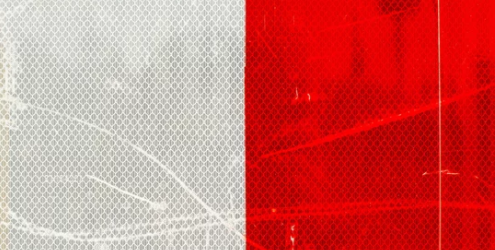Road signs are used to send important messages to drivers about traffic safety, detours, construction, and anything else that might affect driving conditions. Today, almost all road signs are reflective, meaning some of the light from a driver’s headlights is reflected back. This allows drivers to easily see important signs and notices while traveling at night. We all drive past these road signs, but what exactly makes them reflective?
History of Reflective Road Signs
The first road signs were made out of metal and painted yellow or white. These lighter colors provided better contrast between the background and the black letters, which was especially useful at night when headlights hit a sign. However, these signs still didn’t have great visibility during dark hours.
In 1939, Harry Heltzer, an employee of 3M, developed the first reflective tape. This tape was originally designed for the center strip of roadways and used small glass beads to increase reflectivity. This tape was then adapted to be used on road signs. The first sign with this reflective sheeting went up on a street in Minneapolis. Since then, many improvements have been made to reflective sheeting to bring us the road signs we have today.

Reflective Road Sign Materials
Road signs are reflective thanks to the glass beads, microprisms, or encapsulated lenses present on reflective sheeting. These materials bend light, so it comes back to the source, making road signs highly visible at night to drivers with their headlights on. There are three different grades of this sheeting: engineer, high-intensity, and diamond.
Engineer Grade Reflective Signs
Engineer grade signs use glass beads or prismatic optical technology to reflect light and have the lowest prices. Engineer grade signs have less visibility, usually around 400 to 600 feet, making them only suitable for non-critical uses. You will often see these signs in areas like parking lots and garages.
High-Intensity Grade Reflective Signs
High-intensity signs use cube-corner or prismatic material to offer superior reflectivity. Most cities use these for their traffic signs. You will also see high-intensity grade reflective signs used for barricades and construction zones. They provide better visibility than engineer grade signs and can be seen from around 800 to 1,200 feet away. They work well in areas where street lights can affect reflectivity.
Diamond Grade Reflective Signs
Diamond grade signs have the highest visibility, around 1,300 to 1,600 feet. They are used in areas where high visibility is critical, including interstate highways. These are the best option for cluttered urban environments that have a lot of lights and other signs.
Shop Reflective Road Signs and More at Municipal Supply & Sign Co.
Municipal Supply & Sign Co. is one of the largest road signs and safety-related products in the Southeastern United States. Our inventory of signs includes quality reflective road signs for everything from school zones to traffic control. We offer engineer-grade signs for non-critical signs like those for parking garages, and we have high-intensity and diamond-grade reflective sheeting for other signs.
We also carry the other supplies you need, like hardware, brackets, and tools. Browse our full selection today to find the right signs to meet your needs. If you have any questions or would like additional information about our products, please contact our team.


Stay ahead of the pack with the Nike Air Max SC CW4555 102 – Men’s Road Running Shoes, engineered to help you go the distance. https://joyofshoes.com/ nike running shoes